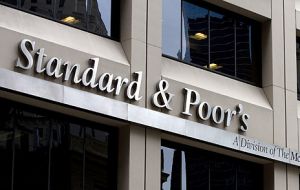MercoPress. South Atlantic News Agency
S&P upgrades US credit outlook to ‘stable’; government debt 84% of GDP
 In August 2011, S&P was the first to downgrade US sovereign debt
In August 2011, S&P was the first to downgrade US sovereign debt Credit rating agency Standard & Poor's On Monday upgraded its credit outlook for the United States government to “stable” from “negative,” saying the chances of a downgrade of the country's rating is “less than one in three.”
In August 2011, S&P became the first credit rating agency to downgrade the sovereign US credit rating from top-rated “AAA” to “AA+,” the second highest rating, and had left the US credit outlook at “negative” at that time.
S&P said in a release that the recent improvements in tax receipts and steps taken to address longer-term budget issues improved the outlook for the United States. However the agency raised concerns about the ability of policymakers to tackle long-standing issues due to a deepening of a partisan divide in Washington in the last decade, however.
“We believe that our current 'AA+' rating already factors in a lesser ability of U.S. elected officials to react swiftly and effectively to public finance pressures over the longer term in comparison with officials of some more highly rated sovereigns and we expect repeated divisive debates over raising the debt ceiling,” the agency said in a statement.
US government as a percentage of GDP will likely be stable at about 84% for the next few years, S&P said. That may give policy makers additional time to address spending on Social Security and health care, which is expected to grow as the population ages, S&P said.
“The improving U.S. economy is boosting government revenues, the sequester has trimmed spending, and uncertainties about growth in China and Europe make the United States the preferred destination for global investors,” said Phillip Swagel, former Treasury assistant secretary for economic policy in the George W. Bush administration and now a professor at the University of Maryland. Automatic budget cuts, known as sequestration, began to go into effect March 1.
Rival agencies Moody's and Fitch currently both hold triple-A ratings on the United States. Moody’s has said U.S. policy makers must address debt loads projected to rise later this decade to avoid a downgrade.




Top Comments
Disclaimer & comment rules-

-

-

Read all commentsIt must be so hard for idiots like Toby when actual facts get in the way of his fantasy.
Jun 10th, 2013 - 08:36 pm 0What will happen when we start EXPORTING our MASSIVE Gas and OIl?
Even at U$2/day China can no longer compete with our mfg in country due to the cheap cheap cheap fuel.
“China can no longer compete with our mfg in country”
Jun 11th, 2013 - 01:48 am 0I see tons of “Made in China” products on U.S. shelves. We all see this.
It seems you are saying very soon many of these will be replaced with, “Made in U.S.A.” products because they can no longer compete with U.S. mfg.
But somehow I don't see that happening anytime soon. Do you? Or have I misunderstood what you said?
Actually, the U.S. is still #2 biggest manufacturer in the world. It's just pricey stuff like Boeing jets.
Jun 11th, 2013 - 06:15 am 0Yep, the North American oil supply is being foreseen as affecting oil prices in a downward way similar to the 10x rise in the last decade.
I like a no-car exhaust world so ill stick w Hawaii's solar & EV plan. :)
Commenting for this story is now closed.
If you have a Facebook account, become a fan and comment on our Facebook Page!